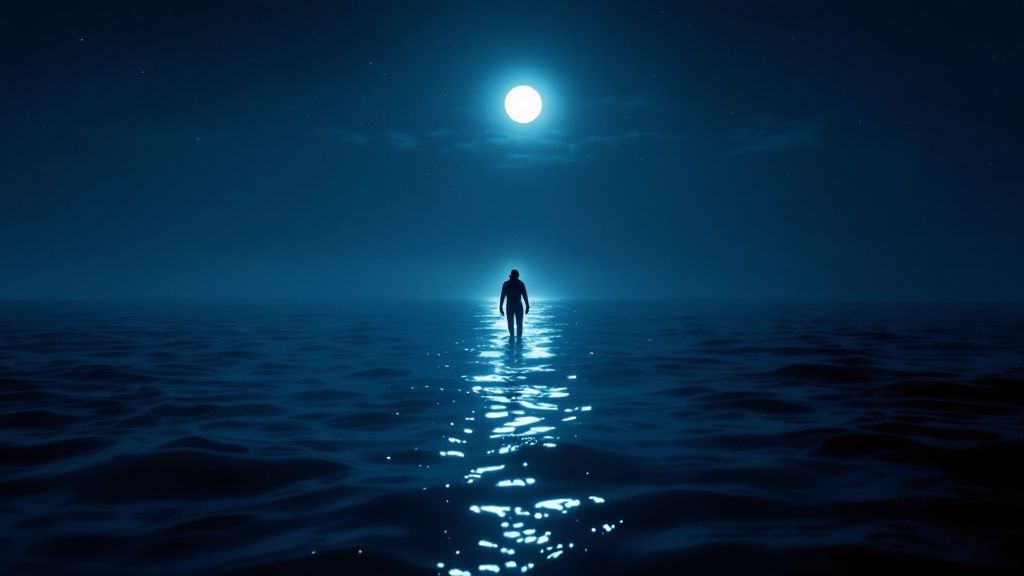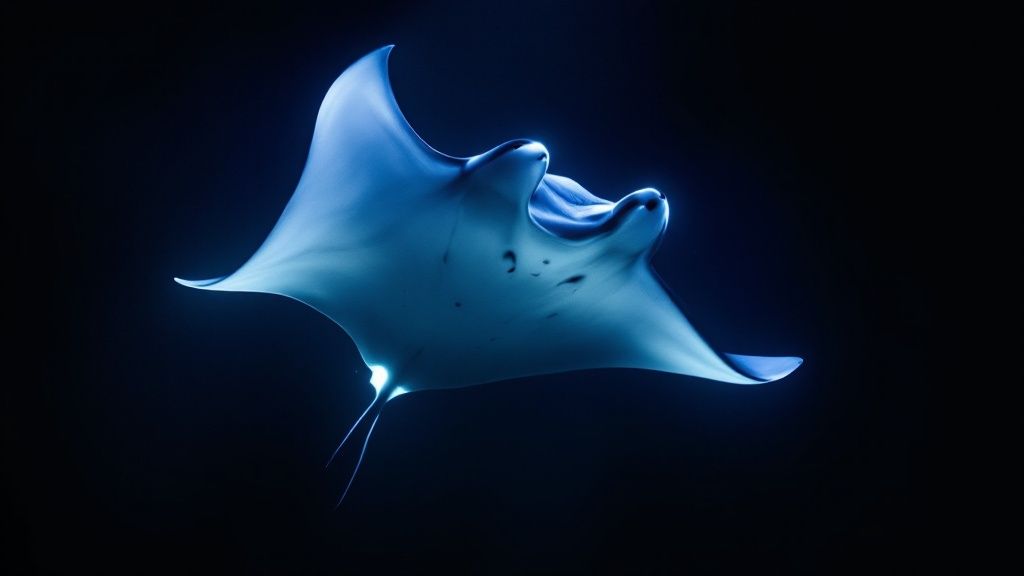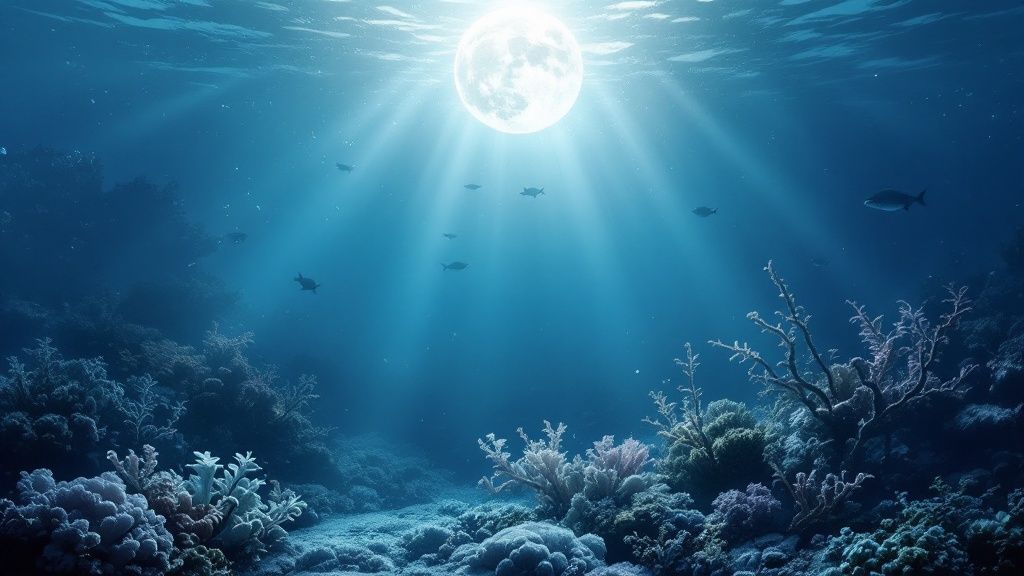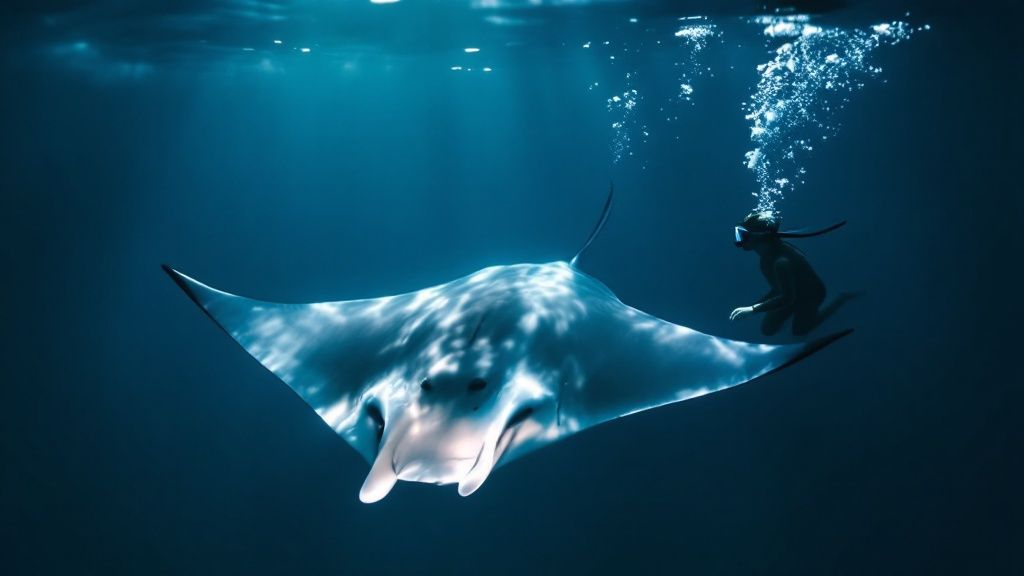Manta Ray Night Snorkeling: Experience Ocean Magic Up Close
- Byron
- Mar 14
- 12 min read
The Magic of Manta Ray Night Snorkeling
Imagine floating in the dark ocean, the only light coming from the moon and your snorkel boat. Then, a giant manta ray, with a wingspan of up to 15 feet, appears from the depths. This is the magic of manta ray night snorkeling, an unforgettable experience for ocean lovers.
This unique adventure offers dramatically better viewing than daytime trips. During the day, manta rays are spread out, searching for food. But at night, they gather around lights, attracted by the plankton they illuminate. This creates a beautiful underwater dance as the mantas perform mesmerizing loops, sometimes just inches from snorkelers.
These specialized lights mimic natural bioluminescence, drawing in plankton and, consequently, the manta rays. This creates a reliable way to see these gentle giants in action. 
Why Choose Night Snorkeling?
Darkness enhances the manta ray experience. The focused lights create a dramatic contrast, highlighting the mantas against the dark ocean. The illuminated plankton adds another layer of beauty. Think of a spotlight on a dancer on a dark stage – the darkness emphasizes the dancer's movements. Similarly, the dark ocean and focused lights create a truly unforgettable encounter. The combination of darkness, lights, and the mantas' natural behavior creates an exceptional wildlife experience.
The Emotional Impact
The emotional impact of this experience contributes to its growing popularity. Seeing these graceful creatures up close, their immense size combined with their gentle nature, inspires awe and wonder. It goes beyond simple observation, fostering a deeper appreciation for the ocean's balance. It's a chance to connect with nature on a profound level, a feeling that lingers. This often inspires a sense of responsibility towards ocean conservation, making manta ray night snorkeling not just an adventure, but a call to action.
World-Class Destinations For Unforgettable Encounters

While the magic of manta ray night snorkeling exists around the world, some destinations offer truly exceptional encounters. Choosing the right location significantly impacts the quality of your experience. From well-known manta ray havens to hidden gems, let's explore some world-class options for your next adventure.
Kona Coast, Hawaii: The Manta Ray Capital
The Kona Coast of Hawaii, especially Keauhou Bay, is known as the manta ray capital of the world. Decades of responsible tourism have created a thriving ecosystem where manta rays and humans interact sustainably. Manta ray night snorkeling in Kona is a popular activity. Between 2009 and 2014, researchers documented over 60 individual mantas at Manta Village and Manta Heaven, with some appearing almost every night. Find more detailed statistics here The clear, calm waters and consistent plankton blooms create ideal feeding grounds for these gentle giants.
Maldives: Protected Marine Sanctuaries
The Maldives, a collection of islands in the Indian Ocean, provides another incredible setting for manta ray night snorkeling. Manta rays flourish within the protected marine sanctuaries, allowing for close encounters in pristine waters. The unique underwater topography and diverse marine life enhance the experience. Many Maldives resorts actively participate in manta ray research and conservation, making your visit contribute to a larger effort.
Socorro Islands, Mexico: A Remote Paradise
For a more off-the-beaten-path experience, the Socorro Islands off Mexico's coast offer a remote paradise for manta ray encounters. These volcanic islands attract diverse marine life, including large populations of giant manta rays. The challenging journey rewards you with unparalleled underwater visibility and the chance to see manta rays in a truly wild setting.
Other Hidden Gems: Exploring Beyond The Popular
Beyond these popular spots, many lesser-known locations offer incredible manta ray night snorkeling. These hidden gems often provide a more intimate, less crowded experience. Locations in Indonesia, Fiji, and the Yap Islands are emerging as exciting alternatives. Check out our guide on Manta Ray Night Snorkeling Tours for more ideas.
The table below summarizes some of the top destinations for manta ray night snorkeling:
Top Manta Ray Night Snorkeling Destinations: Comparison of the world's best locations for manta ray night snorkeling experiences
Destination | Best Time | Average Sightings | Experience Level | Notable Features |
|---|---|---|---|---|
Kona, Hawaii | Year-round | High (often multiple per dive) | Beginner to Advanced | Calm waters, established tour operators |
Maldives | November to April | High (especially in designated feeding areas) | Beginner to Advanced | Pristine reefs, diverse marine life |
Socorro Islands, Mexico | November to May | Moderate to High | Intermediate to Advanced | Remote location, large manta rays |
Yap, Micronesia | Year round, peak November to May | Moderate | Intermediate to Advanced | Unique culture, diverse shark species |
Fiji | May to October | Moderate | Beginner to Advanced | Soft coral reefs, warm waters |
Komodo National Park, Indonesia | April to November | Moderate | Beginner to Advanced | Strong currents, diverse marine life including other pelagic species. |
This table provides a snapshot of the diverse opportunities available for manta ray night snorkeling. Each destination offers unique features and caters to various experience levels.
Choosing The Right Destination For You
Choosing the right destination depends on your experience level, budget, and desired interaction. Some locations, like Kona, are easily accessible and cater to all experience levels. Others require more planning and advanced snorkeling skills. Research each destination's specific requirements and offerings before making a decision. No matter where you choose, witnessing these gentle giants in their natural habitat will be unforgettable.
Perfect Timing: Maximizing Your Manta Encounters
Forget what you might assume about the "best" time to snorkel with manta rays at night. The truth is, boosting your chances of an encounter involves understanding the complex interplay of factors influencing manta ray behavior. These factors include everything from the concentration of plankton, the foundation of their diet, to the lunar cycles that affect tides and currents.
Decoding Manta Ray Behavior: Plankton, Tides, and More
Manta rays are filter feeders, consuming massive amounts of microscopic plankton. Therefore, understanding plankton blooms is key. These blooms are often connected to lunar cycles, the upwelling of nutrient-rich water, and even rainfall. This means some locations have year-round manta ray sightings, while others have more distinct seasons. Changing ocean temperatures and currents can also influence feeding patterns, making predictability a constant challenge.
Location, Location, Location: Understanding Regional Variations
Some destinations offer remarkably reliable manta ray encounters. For example, Kona, Hawaii, boasts sightings over 80% of the time at popular spots like Manta Ray Heaven/Garden Eel Cove. On average, around six manta rays are seen per night, although some nights have far more, with records exceeding 36 mantas in a single dive. Even in Kona, however, manta ray presence can fluctuate unpredictably. Discover more insights about Kona manta ray sightings. This inherent unpredictability emphasizes the unique nature of each encounter and the importance of planning your trip wisely.
Managing Expectations and Interpreting Sighting Reports
It's crucial to approach manta ray night snorkeling with realistic expectations. Even the most consistently reliable locations experience occasional days without sightings. Understanding this helps manage potential disappointment and appreciate the truly wild nature of these animals. Be cautious of overly optimistic sighting guarantees. While tour operators offer valuable information, remember that these are wild animals, and their behavior remains unpredictable.
Climate Change and its Impacts on Manta Ray Encounters

Our planet's changing climate further complicates predicting manta ray behavior. Shifting ocean temperatures and currents are disrupting established feeding patterns, making seasonal trends less reliable. This underscores the ongoing need for research and adaptation in manta ray conservation. Supporting responsible tour operators who prioritize data collection and environmental stewardship is more important than ever.
Practical Tips for Timing Your Snorkel
Research your chosen destination thoroughly: Understand the typical manta ray seasonality, peak sighting times, and local environmental conditions.
Consult with reputable tour operators: Local experts can offer current information on recent sightings and ocean conditions.
Be flexible with your schedule: If you can, allow for flexibility in your itinerary to accommodate potential rescheduling due to weather or manta ray activity.
Manage your expectations: Embrace the element of surprise and appreciate the rare nature of these encounters, even if you don't see mantas on your first try.
By understanding these factors and planning accordingly, you can significantly improve your chances of a truly unforgettable manta ray night snorkeling experience.
Insider's Guide to Manta Ray Night Snorkel Tours

So, you're thinking about experiencing the magic of a manta ray night snorkel? This guide will walk you through a typical tour, from the initial briefing to the incredible moment you see your first manta.
From Shore to Sea: The Tour Experience
Most tours start with a briefing on shore. Your guides will cover important safety procedures, explain the tour's structure, and offer some fascinating background information on manta rays. This is also your chance to ask any questions and address any concerns. Many people are understandably a little nervous about entering the ocean at night. Rest assured, experienced guides understand this and will put you at ease.
Next, you'll head to the snorkel site. Most manta ray night snorkel locations use light-assisted feeding stations. These special lights, often attached to floating platforms, attract plankton, which then draws the manta rays. This creates a predictable viewing area and excellent visibility.
Manta ray viewing is a popular activity in Kona, with many tour operators and participants. As of 2015, there were at least 42 commercial tour operators visiting the two primary viewing sites. The number of boats and people in the water varies, averaging 12 to 13 boats per night, and sometimes doubling on busy nights. Peak activity usually happens 30 to 45 minutes after sunset, with hundreds of snorkelers and divers in the water at once. This demonstrates the importance of responsible tourism and choosing a reputable tour operator. Learn more about manta ray viewing operations
Under the Surface: The Manta Ray Encounter
Once in the water, you'll typically hold onto a floating platform equipped with the lights. This helps you conserve energy and stay in place, especially if there's a current. This positioning is key for the best views because the manta rays will feed around the illuminated area.
When the manta rays arrive, they'll begin their graceful underwater dance, often performing looping dives as they feed on the plankton. These loops bring them remarkably close to the surface, allowing for unforgettable close encounters. Manta rays are known for their gentle nature and don't seem bothered by snorkelers. This allows you to observe their natural behavior up close, creating a truly immersive experience.
Group Dynamics and Atmosphere
While everyone's focus is on the manta rays, the shared experience creates a surprisingly social atmosphere. People quickly connect over the wonder of the encounter, sharing excited whispers and gasps of amazement. This shared sense of awe enhances the experience, making it even more memorable.
Photography and Equipment
Many tours permit underwater photography. However, using flash photography is generally discouraged as it can disturb the manta rays and other marine life. Consider using a GoPro or another underwater camera suitable for low-light conditions. Some tours even offer professional photography packages so you can relax and enjoy the experience without worrying about taking photos.
No-Show Contingencies
Manta rays are wild animals, and sightings aren't guaranteed on every tour. Reputable operators often offer a "manta guarantee." If you don't see any mantas, you can usually rebook for free on another night. This helps avoid disappointment and gives you another opportunity to experience the magic of manta ray night snorkeling.
Essential Gear and Preparation for Optimal Experiences
The difference between a magical manta ray night snorkeling experience and a disappointing one often comes down to preparation. Knowing what to bring and what to expect can significantly improve your comfort and enjoyment. Let's explore the essentials for a successful encounter.
Gear Up for Success: What to Bring and Why
The right gear can transform your manta ray night snorkeling experience. While most tour operators provide basic equipment, bringing your own personalized items can greatly enhance your comfort and confidence.
Wetsuit: A wetsuit is crucial for warmth, as even tropical waters can cool down at night. The required thickness depends on the location and season. A 3mm wetsuit might be sufficient in Kona during the summer, while a 5mm suit may be necessary in colder months or other locations. A properly fitted wetsuit will also improve buoyancy and reduce fatigue.
Mask and Snorkel: A well-fitting mask is essential for clear underwater vision. If you have a mask you know fits well, bring it. Otherwise, carefully test any provided rental mask to ensure a good seal and a comfortable fit. This prevents water leakage and fogging, maximizing your viewing time.
Fins: Fins provide propulsion and allow you to move easily in the water. If you own fins that fit comfortably and don’t cause cramping, bring them. If renting, try on different sizes to find the best fit.
Underwater Camera (Optional): Capturing your manta ray encounter creates lasting memories. GoPro or other waterproof cameras are excellent choices. Remember to avoid flash photography, which can disturb the manta rays. A red filter for your underwater camera can improve color balance in blue light conditions.
Beyond the Basics: Enhancing Comfort and Safety
Besides essential snorkeling gear, several other items can enhance your experience.
Towel and Dry Clothes: You'll appreciate having dry clothes and a warm towel after your snorkel. The ocean air can be chilly at night, and changing quickly will help prevent you from getting cold.
Seasickness Medication: If you are prone to seasickness, taking medication beforehand can be helpful. Even short boat rides can be rocky, and feeling nauseous will detract from the experience. Ginger candies or acupressure bands are natural alternatives.
Reef-Safe Sunscreen: Apply reef-safe sunscreen before the tour. This protects your skin during pre-tour activities and minimizes the introduction of harmful chemicals into the ocean.
Mental Preparation: Easing Anxieties for First-Timers
Many first-time night snorkelers experience anxiety about entering the ocean in darkness. Proper mental preparation can significantly reduce these fears.
Focus on Your Breathing: Deep, slow breaths help relax your body and reduce anxiety. Practice this technique before entering the water. Visualize the experience and focus on the positive aspects of the encounter.
Trust Your Guides: The tour guides are experienced professionals who prioritize your safety and will provide clear instructions. Don’t hesitate to express any concerns or ask questions.
Stay Close to the Group: Staying close to the group and the illuminated platform provides a sense of security. It also maximizes viewing opportunities, as the manta rays tend to congregate around the light. Communicate with your fellow snorkelers and share the excitement. You might be interested in: How to master...
Before heading out on your adventure, take a look at the following checklist to make sure you’re well-prepared.
Essential Gear Checklist for Manta Ray Night Snorkeling Comprehensive list of recommended equipment and preparations for a successful experience
Item | Importance | Rent or Bring | Notes |
|---|---|---|---|
Wetsuit | Essential for warmth | Rent or Bring | 3mm-5mm thickness depending on location and season |
Mask and Snorkel | Essential for clear vision | Rent or Bring | Ensure a good fit to prevent leaks and fogging |
Fins | Important for maneuverability | Rent or Bring | Comfortable fit is crucial to avoid cramping |
Underwater Camera | Optional | Bring | Avoid flash photography; red filter recommended |
Towel and Dry Clothes | Essential for comfort after snorkeling | Bring | Helps prevent getting cold in the night air |
Seasickness Medication | Optional but recommended for those prone to seasickness | Bring | Can significantly improve comfort during boat rides |
Reef-Safe Sunscreen | Important for skin protection and environmental responsibility | Bring | Apply before the tour, even for night snorkeling |
This checklist highlights the key items you’ll need for a comfortable and enjoyable experience. Remember, proper preparation is key to a successful manta ray night snorkeling adventure.
By following these gear and preparation tips, you’ll be ready for a truly memorable manta ray night snorkeling adventure.
Being Part of the Solution: Conservation in Action
Your manta ray night snorkeling adventure offers more than just an incredible experience. It's a chance to contribute to the protection of these vulnerable creatures. By choosing to participate, you're entering a world where tourism and conservation intersect.
Understanding the Threats to Manta Rays
Manta rays face several serious threats. Targeted fishing, driven by the demand for their gill plates, is a major danger. Manta Ray Conservation provides further insights into these issues.
Habitat degradation, including pollution and coral reef destruction, also impacts their survival. Like many ocean species, manta rays are affected by bycatch – the accidental capture in fishing nets. These combined pressures have led to declining populations globally, highlighting the urgent need for conservation.
Choosing Responsible Tour Operators
Selecting a responsible tour operator is crucial. Look for operators who prioritize animal welfare. A responsible operator will adhere to strict guidelines for interaction.
Maintaining a safe distance
Prohibiting touching
Limiting the use of lights
They'll also educate guests about manta ray biology and conservation. Ask about their conservation practices, and choose operators committed to sustainable tourism. Some contribute a portion of their profits to research and conservation projects, making your trip a direct investment in manta ray protection.
Citizen Science: Turning Tourists into Researchers
Many manta ray night snorkeling tours offer opportunities for citizen science. Tourists can participate in data collection, providing valuable information to researchers.
You might be asked to help identify individual manta rays based on their unique underside markings. This data helps scientists track populations, monitor movements, and understand manta ray behavior. By participating, you become an active contributor to research and conservation.
Supporting Conservation Beyond Your Trip
The impact of your experience can extend beyond your trip. You can continue to support conservation efforts by donating to organizations dedicated to manta ray research and protection.
Raising awareness by sharing your experience and educating others about the importance of manta ray conservation amplifies the impact of your encounter. Even small actions, like reducing your plastic consumption and choosing sustainable seafood, contribute to a healthier ocean environment.
Sustainable Tourism: A Win-Win for Mantas and Communities
Sustainable tourism offers a model where encounters become part of the solution. By creating economic incentives for protecting manta rays and their habitat, local communities benefit directly from conservation.
This win-win approach fosters a sense of shared responsibility, ensuring the long-term survival of these majestic creatures while supporting local economies. Success stories demonstrate the powerful impact of sustainable tourism, where visitor experiences directly fund crucial research and conservation initiatives. This creates a cycle where tourism supports conservation and conservation enhances tourism.
Book your unforgettable Manta Ray Night Snorkel Kona Hawaii Tour today! Experience the magic!
Comments